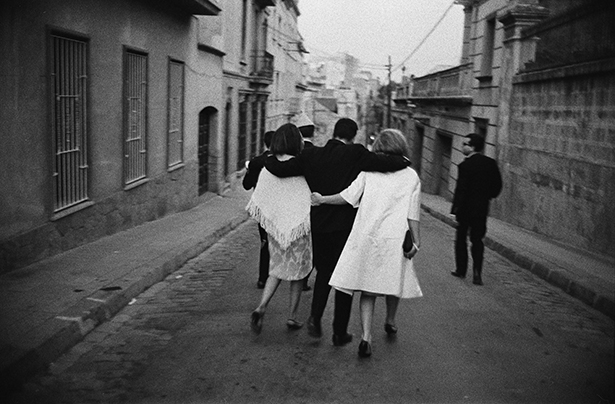Miserachs Barcelona
18 September 2015–27 March 2016
MACBA
Plaça dels Àngels, 1
08001 Barcelona
The Museu d’Art Contemporani de Barcelona (MACBA) is dedicating an exhibition to the Barcelona-based photographer Xavier Miserachs (1937–1998), whose work has been on long-term loan to the Museum since 2011. Miserachs Barcelona, focusing on the photobook Barcelona, blanc i negre (1964) offers a journey through time in which the images are arranged in the form of large murals, shop-windows, enlargements and projections, proposing new ways of seeing and reading photographs in the exhibition space. The exhibition will include a photography seminar and make available to the public Miserachs’ archive.
In September 1964, Miserachs published his major work, Barcelona, blanc i negre, a photobook bringing together nearly 400 of his photographs. From 1961, Miserachs worked professionally in advertising, photojournalism and, above all, street photography, “the pleasure of wandering around trying to represent what to me seemed distinctive and significant about the place.”
Miserachs participated in some exhibitions, but believed the best place for photos was in the pages of magazines and books. He wanted to make “a strictly photographic book of free style and content,” composed of images forming a set that can be read and watched like a film or novel. That is, a photobook—the model that at that time defined the history of photography, marked by the publication of masterpieces such as Life is Good & Good for You in New York by William Klein (1956) and The Americans by Robert Frank (1958).
Barcelona, blanc i negre draws on two models. The first is The Family of Man, a travelling exhibition initiated by the Museum of Modern Art in New York in 1955. It was here that Miserachs realised his true vocation and discovered that the photography that is often called “humanistic” and refers to abstract concepts can also serve to “tell, communicate, explain and increase the knowledge of others through our own experience.” The second is identified with the urban photobooks of William Klein, whom Miserachs admired for his “highly original way of portraying cities by focusing on the signs provided by their people and spaces.”
Barcelona, blanc i negre begins with a carefully disordered sequence that bursts into the city one morning. Later, you discover the city through its inhabitants, with stories of work and celebration, newly arrived migrants and the bourgeoisie of good families, slums, the Gothic quarter and Eixample, shop windows, advertisements and grafitti…and always people in the streets, of all ages and classes. The photobook seems to follow a classic maxim: “The city is its people.” Miserachs avoids tourist and historical clichés, preferring to delve into the theme of modern culture, the urban experience and its space: the city.
The great narratives of literature, film and photography of the last century are urban, and their heroes are waylaid walkers such as Eugène Atget, the pioneer of street photography, the active equivalent of the flâneur described by Charles Baudelaire and studied by Walter Benjamin. Like “the painter of modern life” of the Parisian poet, Miserachs is a curious passerby, an indefatigable pedestrian who walks the streets, markets and parks, browsing in shop windows and pavement cafes, stopping by the factories at knocking-off time and in station waiting rooms, and who ends the day on the dance floors and in the all-night bars.
Photobooks invite us to look and read. To adapt these actions to the museum, the exhibition Miserachs Barcelona proposes several ways of looking at and reading photos in the art space. The viewer encounters the photos of Barcelona, blanc i negre arranged in the form of large murals, shop-windows, enlargements and projections.
The exhibition opens with a twilight panorama, both unreal and documentary, that refers to the distant horizons of the cinema. Next, you enter the city, recreated in a Meccano-like construction that evokes the style of exhibition displays during the years in which Miserachs prepared his photobook. It is a model that began in the lecture halls of the Bauhaus and reached its photographic zenith with the portable structures used for The Family of Man.
Later, you can literally walk through the pages of Miserachs’ photobook and the crowded streets and squares of a Barcelona without tourists, thanks to large three-dimensional enlargements that transform the space into a stage design in which the viewer becomes an active participant. A further space is dominated by changing projections, in which the viewer is immersed in a past and present that constantly merge. Finally, Barcelona, blanc i negre is displayed on a screen in full detail. Here we also find copies of the photobook and the meandering itineraries followed by Miserachs during its preparation.
Exhibition organised and produced by MACBA.
Curator: Horacio Fernández
Publication
Miserachs Barcelona offers a selection of images from the book Barcelona, blanc i negre (1964), offering a new perspective on the original work. Barcelona: MACBA/RM, 2015. Trilingual edition (Catalan, Spanish, English). Two versions: library and portfolio.
A.XMI
From 12 November to 27 March, MACBA will make available to the public a selection of photographic and documentary materials from the Xavier Miserachs Fonds, together with an overview of the working processes that the Archive of the MACBA Study Centre undertook in order to incorporate, catalogue and publicise this important photographic collection.

